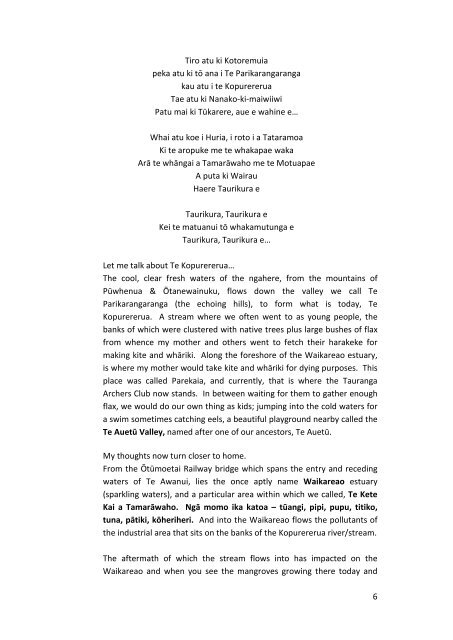(TAKUTAI MOANA) BILL E kau I te wai e, e kau I te wa
(TAKUTAI MOANA) BILL E kau I te wai e, e kau I te wa
(TAKUTAI MOANA) BILL E kau I te wai e, e kau I te wa
Create successful ePaper yourself
Turn your PDF publications into a flip-book with our unique Google optimized e-Paper software.
Tiro atu ki Kotoremuia<br />
peka atu ki tō ana i Te Parikarangaranga<br />
<strong>kau</strong> atu i <strong>te</strong> Kopurererua<br />
Tae atu ki Nanako-ki-maiwiiwi<br />
Patu mai ki Tūkarere, aue e <strong>wa</strong>hine e…<br />
Whai atu koe i Huria, i roto i a Tataramoa<br />
Ki <strong>te</strong> aropuke me <strong>te</strong> whakapae <strong>wa</strong>ka<br />
Arā <strong>te</strong> whāngai a Tamarā<strong>wa</strong>ho me <strong>te</strong> Motuapae<br />
A puta ki Wairau<br />
Haere Taurikura e<br />
Taurikura, Taurikura e<br />
Kei <strong>te</strong> matuanui tō whakamutunga e<br />
Taurikura, Taurikura e…<br />
Let me talk about Te Kopurererua…<br />
The cool, clear fresh <strong>wa</strong><strong>te</strong>rs of the ngahere, from the mountains of<br />
Pūwhenua & Ōtane<strong><strong>wa</strong>i</strong>nuku, flows down the valley we call Te<br />
Parikarangaranga (the echoing hills), to form what is today, Te<br />
Kopurererua. A stream where we of<strong>te</strong>n went to as young people, the<br />
banks of which were clus<strong>te</strong>red with native trees plus large bushes of flax<br />
from whence my mother and others went to fetch their harakeke for<br />
making ki<strong>te</strong> and whāriki. Along the foreshore of the Waikareao estuary,<br />
is where my mother would take ki<strong>te</strong> and whāriki for dying purposes. This<br />
place <strong>wa</strong>s called Parekaia, and currently, that is where the Tauranga<br />
Archers Club now stands. In between <strong><strong>wa</strong>i</strong>ting for them to gather enough<br />
flax, we would do our own thing as kids; jumping into the cold <strong>wa</strong><strong>te</strong>rs for<br />
a swim sometimes catching eels, a beautiful playground nearby called the<br />
Te Auetū Valley, named af<strong>te</strong>r one of our ancestors, Te Auetū.<br />
My thoughts now turn closer to home.<br />
From the Ōtūmoetai Rail<strong>wa</strong>y bridge which spans the entry and receding<br />
<strong>wa</strong><strong>te</strong>rs of Te A<strong>wa</strong>nui, lies the once aptly name Waikareao estuary<br />
(sparkling <strong>wa</strong><strong>te</strong>rs), and a particular area within which we called, Te Ke<strong>te</strong><br />
Kai a Tamarā<strong>wa</strong>ho. Ngā momo ika katoa – tūangi, pipi, pupu, titiko,<br />
tuna, pātiki, kōheriheri. And into the Waikareao flows the pollutants of<br />
the industrial area that sits on the banks of the Kopurererua river/stream.<br />
The af<strong>te</strong>rmath of which the stream flows into has impac<strong>te</strong>d on the<br />
Waikareao and when you see the mangroves growing there today and<br />
6






![Full evidence text [PDF 8908k] - New Zealand Parliament](https://img.yumpu.com/14025494/1/184x260/full-evidence-text-pdf-8908k-new-zealand-parliament.jpg?quality=85)
![−3 JUN 2009 IRELEASED] - New Zealand Parliament](https://img.yumpu.com/12829724/1/185x260/3-jun-2009-ireleased-new-zealand-parliament.jpg?quality=85)
![Full paper text [PDF 3515k] - New Zealand Parliament](https://img.yumpu.com/11267192/1/184x260/full-paper-text-pdf-3515k-new-zealand-parliament.jpg?quality=85)


![Full evidence text [PDF 9k] - Parliament](https://img.yumpu.com/7938085/1/184x260/full-evidence-text-pdf-9k-parliament.jpg?quality=85)





